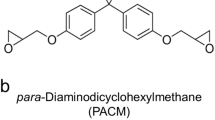Abstract
The interface between a highly-crosslinked polymer film and a thin silicon nitride layer can be regulated using adhesion promoting molecules. This work compares the effects of both indirect polymer/inorganic interface chemistry modification by blending organosilane adhesion promoting molecules into the polymer layer, and direct modification by confining the organosilane molecules to the substrate surface. Of particular interest are the effects of these modifications on the occurrence of an anomalous subcritical debonding phenomenon previously observed for the unmodified interface. While significantly different adhesion values were measured, the influence of the blended organosilanes was limited to moderating moisture diffusion through the polymer layer, which correllates with moderated near-threshold growth rates. Conversely, nanoscale confinement of the adhesion promoting molecules did not result in expected universal increases in adhesion energy but did inhibit anomalous debonding behavior.
Similar content being viewed by others
References
H. Ishida, Polym. Composite 5, 101 (1984).
E.P. Plueddemann, Silane Coupling Agents, 2nd ed. (Plenum Press, New York, 1991).
M.L. Jenkins, R.H. Dauskardt, J.C. Bravman, J. Adhesion Sci. Technol. 18, 1497 (2004).
H. Dodiuk, S. Kenig, I Liran, J. Adhesion 39, 123 (1992).
M. Sautrot, M.L. Abel, J.F. Watts, J. Powell, J. Adhesion 81, 163 (2005).
K.L Ohashi, S.A. Yerby, R.H. Dauskardt, J. Biomed. Res. 54, 419 (2000).
R.J. Hohlfelder, D.A. Maidenberg, R.H. Dauskardt, Y. Wei, J.W. Hutchinson, J. Mater. Res. 16, 243 (2001).
J.M. Snodgrass, D. Pantelidis, M.L. Jenkins, J.C. Bravman, R.H. Dauskardt, Acta Mater. 50, 2395 (2002).
B.M. Sharratt, L.C. Wang, R.H. Dauskardt, J. Mater. Res. 2006. To be submitted.
M.F. Kanninen, Int. J. Fract. 9, 83 (1973).
A.G. Evans, Int. J. Fract. 9, 267 (1973).
ASTM Standard D638-03. 2005 ASTM Annual Book of Standards, vol. 8.01 (ASTM International, West Conshohocken, PA, 2005) p. 50.
K.M. Liechti, S.T. Schnapp, J.G. Swadener, Int. J. Fract. 86, 361 (1997).
Author information
Authors and Affiliations
Rights and permissions
About this article
Cite this article
Sharratt, B.M., Dauskardt, R.H. The Role of Nanoscale Confinement of Adhesion Promoting Molecules on the Adhesion and Resistance to Moisture Attack at the Polymer/Silicon Nitride Interface. MRS Online Proceedings Library 924, 818 (2006). https://doi.org/10.1557/PROC-0924-Z08-18
Received:
Accepted:
Published:
DOI: https://doi.org/10.1557/PROC-0924-Z08-18




